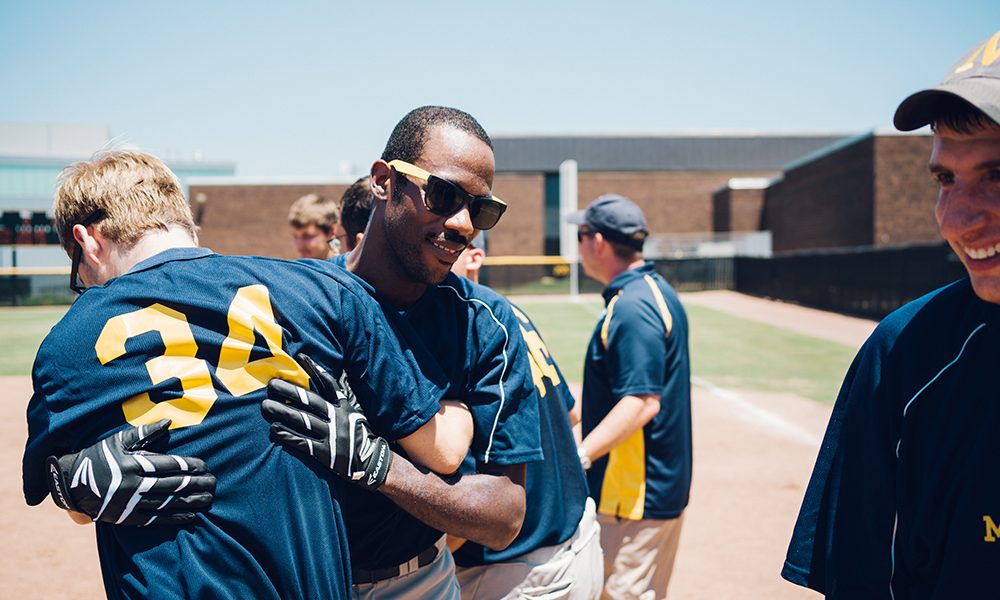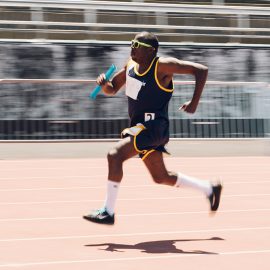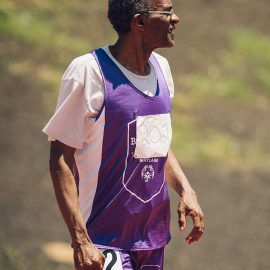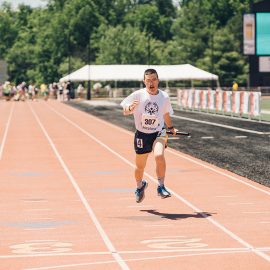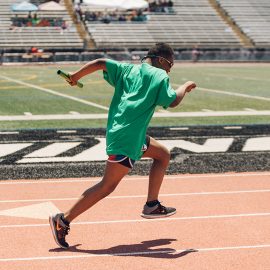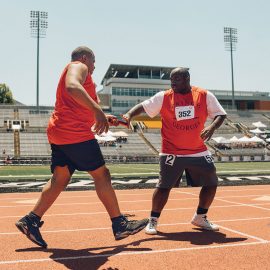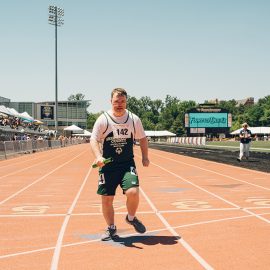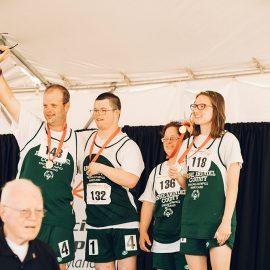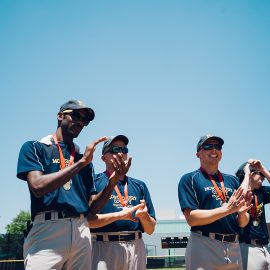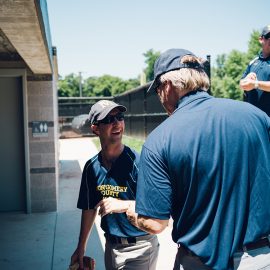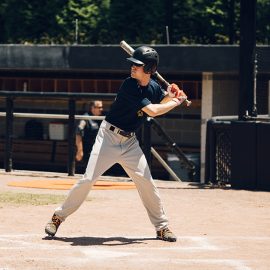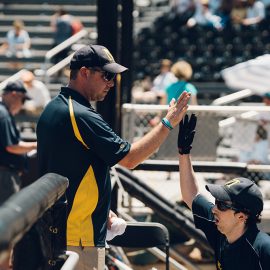News & Community
You Are Here: Gifted
Scenes from Special Olympics of Maryland, Star-Spangled Banner Flag House, and a Tree Bus Tour.
Gifted
June 11, 2017
Auburn Drive
“You can’t run without passing the baton and we’re very good at passing the baton,” says Donnell Banks, 23, moments after he and his three teammates win gold in the 4×400 at the Special Olympics Maryland Summer Games at Towson University. “We practice together every Saturday and we’re very close,” Banks adds with a smile, standing alongside his running mates. “We work well together.”
So well, in fact, this is the third year in a row that the foursome—Banks; Calvin Anderson, 17; Niki Kohli, 17; and Vu Tran, 30—has won gold in the 4×400.
Events at this weekend’s 47th summer games include track and field, swimming, cheerleading, softball, and bocce—and more than 1,500 mostly under-40 competitors.
With temperatures reaching 93 degrees, Lori “Action” Plaxen, 28, who won five medals overall, cools off after her last event beneath the light spray of local fire trucks. “Special Olympics is a family,” says her mother, Joyce, the Montgomery County track and field team manager for the past 10 years. “What can you say? It makes them feel accepted. It makes them feel like they can do anything.
“Look around, too,” she adds. “There is every nationality, race, and religion competing here and getting along and loving each other.”
Along those lines, Jason Schriml, of Special Olympics of Maryland, recalls a favorite moment while coaching the Maryland team at the Special Olympics World Winter Games in Boise and other locations in Idaho. “We were on a long bus ride leaving the opening ceremonies and I dozed off,” Schriml says. “There were teams from Iran, Iraq, Canada, Australia, Switzerland, South America on this bus and when I woke up, they’re all exchanging gear and taking selfies. One guy from India was showing his turban around to everyone. It was surreal.
“We also had four Maryland athletes competing in the snowshoe events in Boise,” Schriml continues. “What amazed me was the team from Egypt. Apparently, they practice with cardboard boxes, tied around their feet with rubber tubes, and train in the sand. I mean, they were good.”
True Colors
June 14, 2017 E. Pratt Street
Historian K. A. Wisniewski clicks his laptop and puts a PowerPoint image of 16 varying red, white, and blue flags on the screen at the Star-Spangled Banner Flag House. Most of the flags include the traditional stars of the American flag in differing configurations—concentric circles and abstract designs, for example—but not all. Wisniewski asks the small crowd how many of those flags were considered the official American flag at one time or another?
“All of the above,” he says, answering his own question.
Wisniewski explains that the U.S. has employed 27 flags since its inception. Early on, different flags were even acknowledged as official American flags at the same time. In fact, to this day, while there’s still debate over the identity of the original seamstress of the flag that became the known as “The Stars and Stripes”—the question over who designed the flag has largely been settled, according to Wisniewski. That would be Declaration of Independence signee Francis Hopkinson. At least, he’s the only known person to have billed Congress for the job.
Wisniewski’s presentation is part of the 90th Flag Dag celebration at the Flag House, which includes a museum and the attached former home of seamstress Mary Pickersgill, who stitched the famous Star-Spangled Banner that flew over Fort McHenry. Events today include free tours, a replica flag-raising, and a performance by Fort McHenry Junior Fife and Drum Corps.
As many Baltimoreans know, Philadelphian Betsy Ross, thanks to aggressive marketing by her ancestors, typically gets credit for designing and sewing the “first” official American flag. However, Wisniewski says, evidence suggests Hopkinson, who lived in Philadelphia and knew both Mary Pickersgill’s family and Betsy Ross, would not have handed his design to Ross. “In one correspondence, Hopkinson pays Betsy Ross a kind of backhanded compliment,” Wisniewski says. “He suggests she was good at something, but it wasn’t sewing.
“In other words, he thought she was a second-rate seamstress.”
Pulp Stores
June 17, 2017 Swann Drive
As the packed bus pulls away from the Howard Peters Rawlings Conservatory and Botantical Gardens at Druid Hill Park, arborist Gary Letteron points out a state champion bur oak, a city champion white ash, and the Grove of Remembrance—pin oak trees, one for each state, planted 25 feet apart—representing the first living memorial to the veterans of World War I.
Letteron, along with Ted Martello, is leading the morning bus portion of TreeBaltimore’s “Notable Tree Bus Tour,” which is headed next to Cylburn Arboretum, but not before passing several massive English oaks near the park’s disc golf course. “We don’t know how old those trees are,” Letteron says, “but there are pictures of Civil War soldiers sitting underneath them. That’s how big they already were then.”
Entering Cylburn, the tour bus passes a showy magnolia in full bloom. Walking the 200-acre arboretum, and now led by Glenda Weber, a naturalist with Baltimore City, attendees get up-close looks at a silver maple, a Himalayan pine, a Chinese chestnut, and a 1970 progeny of the iconic, now-deceased Wye Oak tree, an Eastern Shore specimen once recognized as the nation’s largest white oak.
Later, the three-hour tour heads to Chinquapin Run Park, passes by a weeping cherry donated by Al Capone to Union Memorial Hospital (Johns Hopkins refused to treat the Chicago gangster’s syphilis), and visits Evesham Park and its nearby city champion male ginkgo biloba—a species that dates back 2.5 million years.
Beneath a giant bald cypress at Evesham Park, Weber explains that many trees have a single gender—male trees with flowers that produce pollen, or female trees with “ovaries” that produce fruit. Other trees have both characteristics; still others can switch genders during their lifetimes.
“They are all different and they are all my friends,” she says with a smile while discussing the nuanced gender and reproductive systems of trees. “Look closely and take notice of each one.”
